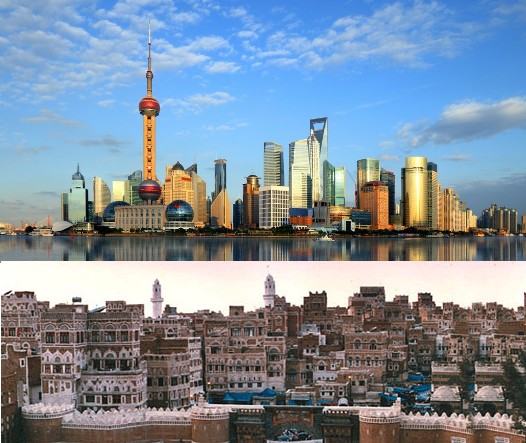 Above, Shanghai and Surat. In our article of 14th December 2012
Above, Shanghai and Surat. In our article of 14th December 2012
http://www.british-gazette.co.uk/2012/12/14/fracking-the-insurance-implications/
we drew the Reader’s attention to an article by Fleur Rochester of Post Online which gave an optimistic assessment of the commercial viability of insuring any fracking operation in the UK.
This clearly is the most important aspect for without insurance commercial fracking cannot proceed unless the government decided to underwrite the risk with taxpayers money. Something the British Gazette would not support.
The second question is contingent upon the first. If the UK’s shale reserves are commercially – not just economically – recoverable then this question is: What do we do with it?
To date, it is generally assumed that the gas will be burned in gas powered generating plants to generate affordable and non subsidised electricity to UK consumers. In our article of 16th November 2014 however
http://www.british-gazette.co.uk/2014/11/16/uk-base-load-capacity-the-most-serious-problem-the-uk-faces/
we suggested that the vast majority of UK base load electricity be generated using AP1000 reactors.
Does that mean the British Gazette has “gone cold” on fracking?
No. The British Gazette has always been in favour of extracting the UK’s reserves of shale gas but on ONE over riding proviso: That such extraction be commercially viable and that NO taxpayer support is necessary.
Assuming the shale reserves can be exploited, we have to consider how to use this important resource.
This means looking into the future.
At the moment the world is in something of an economic downturn. The Eurozone and Japan are in recession. China is slowing down as is Brazil. The USA – for the moment is doing OK. The UK is doing that little bit less OK than the USA – for the moment. Things for us could well slow down.
In the long run however the economic prognosis (and with it the geopolitical ramifications) is reasonably certain: Both China and India will become (over the next four decades – the operational lifetime of a large scale electricity generating plant – not wind turbines which have a life of less than two decades) economic superpowers each with a large middle class. These middle class consumers will consume LARGE amounts of fossil fuels.
Now, as every British Gazette reader knows – but those such as the Unfortunate Ed Miliband have to be reminded of – increased demand when met with less than equal supply generally results in a rise in price. This then is the major advantage the AP1000 has over a fossil fuel plant: its operating costs including importantly the fuel costs are for the most part known in advance.
What we can reasonably predict is that fossil fuel prices will over the next four decades go up. Fossil fuels are of course the what the vast majority of road vehicles use. This will continue to be the case. Electric vehicles will always be a small niche market for wealthy Guardian readers such as the delusional Ed Davey. They CANNOT become mainstream vehicles for the SIMPLE reason that their all important lithium-ion batterie are expensive and use comparitively rare materials.
The two electrodes positive and negative of lithium-ion batteries are made of different materials. For the positive, Lithium Nickel Manganese Cobalt Oxide (“NMC”, LiNixMnyCozO2) superseded Lithium Manganese Oxide (“LMO”, LiMn2O4). For the negative, Graphite is the dominant negative electrode material used in lithium ion batteries as it provides both low cost and good energy density. Graphite anodes can accommodate one lithium atom for every six carbon atoms. Charging rate is governed by the shape of the long, thin graphene sheets. While charging, the lithium ions must travel to the outer edges of the graphene sheet before coming to rest (intercalating) between the sheets. The circuitous route takes so long that they encounter congestion around those edges. A new material, Lithium Titanate (“LTO”, Li4Ti5O12) gives improved output, reduces charging time and improves durability. The liquid electrolytes in lithium-ion batteries consist of lithium salts, such as LiPF6, LiBF4 or LiClO4 in an organic solvent, such as ethylene carbonate, dimethyl carbonate, and diethyl carbonate. Lithium, Nickel, Cobalt, Graphene (only a small amount of graphite is suitable) and Titanium are uncommopn and expensive materials and cause these batteries to be expensive.
The British Gazette apologises to you Dear Reader for stating such obvious facts, but you see the two fools we have just referred to seem incapable of realising such things!
Now let us address the issue for the expected use of power by the soon to be millions of middle class Chinese and Indians. One of the things the Delusional Ed Davey opines about is the seeming (to him) excessive use of power that US people use when compared to his constituents Kingston and Surbiton. Again, we humbly beg your indulgence Dear Reader for another set of obvious statements.
What Ed Davey needs to understand is this: that whilst air conditioning in County of Surrey is generally not essential for comfortable living in August, it is most certainly essential in Shanghai (China) and Surat (India) especially in the monsoon! At the moment most denizens of these two cities have to swelter in the oppressive heat and humidity but when they become richer air conditioning and dehumidification will be first on their list of purchases! This will mean their fuel use will rise exponentially!
This will of course cause the Delusional Ed Davey to fear for the future of Planet Earth, but for the vast majority of sane humans, they will worry about the increasing cost of fuel.
Now you see Dear Reader why the British Gazette considers that the AP1000 is the sensible option.
Speaking the Truth unto the Nation

I have requested Ian R Crane to read and discuss. Hope this is ok